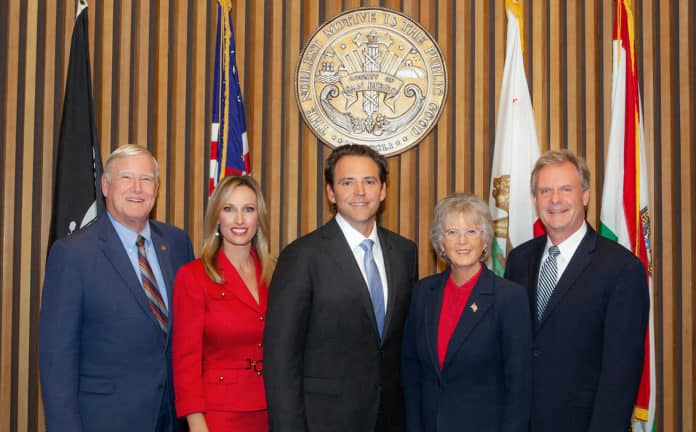By Tracy DeFore, County of San Diego Communications Office
Jun. 10, 2019 | 2:54 PM
The County’s most vulnerable residents are the focus of a new recommended budget formally presented to the County Board of Supervisors Monday. The $6.21 billion budget for Fiscal Year 2019-2020 invests $112 million in new spending for residents struggling to get by in our region.
Increased funding will go toward services for people with mental health or substance use disorders, and those experiencing homelessness or at risk of homelessness. The budget addresses the lack of affordable housing and assists children and families in the foster care system.
The County’s Chief Administrative Officer, Helen Robbins-Meyer, told Board members they will see a significant change in the investment of the health and human services safety net.
“This year’s proposed budget recommends adding 338 new staff years to help people in need. Social workers, nurses, mental health clinicians, housing and aging specialists make up the majority of the proposed new hires,” said Robbins-Meyer. “Discretionary spending in health and human services has nearly doubled since 2017 exemplifying your commitment to our most vulnerable populations.”
Video by James Kecskes
The new plan includes adding $50.3 million to Behavioral Health Services, which covers mental health and substance abuse, bringing its annual budget to $708.5 million.
The increase will support 123 new positions and put $25.3 million into walk-in services for mental health outpatients. It will fund 70 Psychiatric Emergency Response Teams and expand services for residents with severe mental illness who rotate in and out of hospitals.
Another $12.5 million will provide 177 additional psychiatric beds for those needing long-term care. An extra $17.2 million will go to the No Place Like Home program for people experiencing or at risk of homelessness who need mental health services.
San Diegans will get continued access to Drug Medi-Cal systems for treatment of substance use disorder after the County’s investment tripled last year from $54.6 million to $179.6 million annually. The number of people treated is expected to jump 30% over that time period. Substance use disorder often exacerbates mental illness, homelessness and criminal behavior.
The County added $12.4 million to current housing efforts and doubled the original $25 million housing trust fund to $50 million to create affordable housing for homeless families and veterans, older adults with extremely low incomes, those with special needs and others at risk for homelessness. The full $50 million trust fund could result in as many as 1,800 affordable units. Development of four excess County properties will create an additional 700+ affordable units in coming years.
In a bid to increase lower-cost housing in the unincorporated areas, the County is already waiving various fees for homeowners who want to build granny flats, also known as accessory dwelling units. Now steps are underway to develop pre-approved building plans to further lower construction costs.
Child Welfare Services will see another $7.4 million to support 65 new positions and abuse investigations. The funding will also help carry out recommendations by the new Child and Family Strengthening Advisory Board. The increase includes social worker training to reduce family violence and a pilot ridesharing project to help families with visitation.
The budget will also advance services for Alzheimer’s disease. Eighteen new positions will help Public Health Services identify emerging trends and monitor infectious diseases such as measles.
Overall the County is adding 338 staff positions with 270 slated for the County’s Health and Human Services Agency.
In the area of juvenile justice reform, the County will create two new Achievement Centers for young people at risk of returning to juvenile hall. Continued funding for the recreational program Safe Destination Nights will keep 8,000 teens off the streets in the critical evening hours.
Continuing to fund the Fresh Start program will help adults with criminal records overcome barriers to success. The program can reduce felony convictions to misdemeanors, dismiss or expunge criminal records, and offer Certificates of Rehabilitation.
Sustainability remains a high priority. The County is exploring energy options such as community choice energy. The County will continue implementing its Climate Action Plan to reduce greenhouse gases, including planting 3,500 trees on public lands and adding 500 acres of open space to the 41,000 acres already preserved.
The budget includes $103 million for capital projects with funding going toward new Live Well Centers, parks, trails, a fire station and more. Partial funding includes the five-year renovation project for the historic County Administration Center, which kicked off in April.
The budget decreases 1% or $59.7 million from last fiscal year because of reduced spending for one-time capital projects, but anticipated spending for ongoing programs has increased by $322.2 million.
Another public hearing on the balanced budget will take place in the evening and start at 5:30 p.m. on Thursday, June 13.
The budget is part of a two-year operational plan. Budget deliberations and formal adoption of the first year of the budget plan are scheduled for June 25 at 2 p.m. At that time, the Board will also approve the second year in principle for planning purposes.
The public can get more information through the online budget portal and the recommended operational plan. The public can also submit comments to the Board using video or text options through an e-comment website. The online comments, in-person and written feedback options will be available until budget hearings close at 5 p.m. on June 19.
Tracy DeFore is a communications specialist with the County of San Diego Communications Office.


















